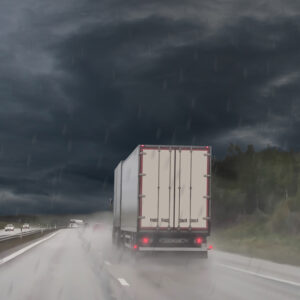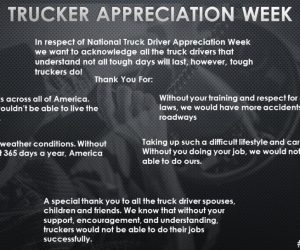We operate daily with many safety concerns, such as speed limits, load weight, hours of service, and freezing and slick driving conditions. Heavy rain, high winds, straight-line winds, winter storms, dust storms, blizzards, and severe weather are also safety concerns. Regardless of the type of weather, driving in harsh conditions can increase the risk of dangerous situations for you and other drivers on the road.

All drivers need complete concentration and have their undivided attention to navigate through the weather. To arm yourself against Mother Nature, the best tip is to stay on top of the weather conditions on your route. Look up weather conditions on weather websites; local radio and television stations are a great place to start.
Awareness is the first step to staying safe in all weather conditions. Spring and fall tend to have more tornadoes, wind, and hail than other seasons. These tips can remind you and help you prepare and stay safe while driving over the road. However, first, you must know and understand the weather terms to determine which steps to take. The National Weather Service usually keeps everyone updated on the impending storms. Either by broadcasting on the radio, television, or an online website.
Do you know your weather terms?
Depending on the severity of a storm, these terms are the most commonly used by the National Weather Service.
- Severe thunderstorm watch: Conditions will likely develop into severe storms that can produce hail and wind gusts of up to 58 mph.
- Severe thunderstorm warning: This is issued when a severe thunderstorm is spotted on radar and occurs in the warning area that can last 30 to 60 minutes.
- Tornado watch: Weather patterns can develop severe thunderstorms that can produce tornadoes in and around the watch area. People in the affected areas are encouraged to be prepared for severe weather and be prepared to take cover if needed.
- Tornado warning: Generally, this means that storm spotters have sighted a tornado or radar has indicated a tornado in the warning area. When a tornado warning is issued, people in the affected area are encouraged to take cover immediately.
Before, during, and after a storm can be dangerous if you are home, but more so if you drive out on the road. Having a wreck can increase during a storm, not only because of the weather but also because of other drivers panicking and the storm’s aftermath. Remember, even if you are calm, other drivers may not be as they forget road rules and speed limits. Be prepared with common sense and caution.
We all know when driving over the road, it is only a matter of time until we cross severe weather. If you can re-route around the storm, do so. If you cannot stay off the road or take shelter – the best advice is to at least stay off the road until the weather passes.
One of the best tips is to keep all distractions at bay and keep the radio turned loud enough to catch the latest weather forecast report but low enough that music is not distracting. Put your cell phone on hands-free or Bluetooth, and try and stay off the CB as much as possible unless notifying other drivers of future road and weather conditions. It is not always practical to avoid all storms, but you can be proactive and plan around the storm.
To stay safe, you need to know how to avoid severe weather or dangerous weather conditions when possible proactively:
Pre-weather planning for your haul
- Before heading out, check the weather for your route.
- If severe or inclement weather is in your path, try and re-route and plan the time to avoid the weather.
- If you cannot re-route, consider postponing and leaving after the weather. Arriving late is better than not arriving at all.
- Remember, other drivers may not be calm; be prepared for the actions/reactions of other drivers.
- Ensure to carry a NOAA weather radio, flashlights, non-perishable food items, water, clean towels, and emergency first aid kits.
Most over-the-road drivers know that stopping distance is a primary concern when driving in risky weather conditions. When driving in precipitation, whether it be rain, freezing rain, snow, or ice, you need room to stop if you lose traction. Sliding on the ice, jack-knifing, or hydroplaning is a truck driver’s worst nightmare.
Big trucks should never use the Jake brake or engine brake in wet weather conditions simply because it could cause loss of traction and could prevent proper braking, steering, or acceleration.
Driving in heavy winds
Most truck drivers do not consider wind a big issue when driving. However, driving in high winds can be quite dangerous, especially in open spaces, highway overpasses, through mountains, and tunnels. Often, these areas act as wind tunnels.
You are a big rig, so you know how difficult it can be to stay in your lane during strong winds. Keep in mind other rigs are probably fighting the same battle. Be prepared. Always keep both hands on the steering wheel in case a wind gust tries to push you out of your lane.
Driving in a tornado
High winds and thunderstorms often spawn tornadoes. Tornadoes are erratic and often change directions, causing flying debris that is often more dangerous than the actual tornado itself.
If a tornado approaches while you are driving, pull over to a safe place and try to get to an indoor shelter, basement, or an interior room.
If you cannot reach the shelter:
- Get off the road. If it is possible, get off the road completely instead of pulling over to the shoulder. Sometimes, it is safer to get off the road and indoors and out of the path of the storm.
- Avoid stopping under bridges and tunnels. Over and underpasses often cause funnel winds that can be most dangerous.
- Get down low. Stay secure in your seat belt in your rig, but leave it running so the airbags work. Get as low as you can below the window with your head down. Cover your head with your hands or a blanket if you have one. The best case scenario is to leave your rig if you can get lower than the road way and lie in the ditch.
Tips for dealing with electricity
Whether due to a lightning strike or down power lines, dealing with high-voltage electricity is dangerous.
If an electric line is touching your truck, do not attempt to get out – instead, wait inside for help. Or try to back up; if you cannot back up safely, call for help. In this case, you must leave the rig, try to jump clear, and not touch the ground and the truck at the same time. Once you land on the ground, shuffle your feet – DO NOT RUN. By keeping both of your feet close together on the ground, it prevents electricity from running through your body.
Driving after a storm
Just because the skies are calm and the storm has passed does not mean the danger is over. The roads can still be slippery from rain and melting hail. Hail often acts like loose gravel and can cause loss of traction. Debris can cover the road, making it hard to navigate. Heavy rains can also cause landslides and wash the road surface out or, worse, flash flooding.
The secret to driving in hazardous situations is to slow down and know when to stop.



 As the saying goes, if you are unable to see the truck mirrors, the truck driver cannot see you. When a big rig cannot see you, th...
As the saying goes, if you are unable to see the truck mirrors, the truck driver cannot see you. When a big rig cannot see you, th...

